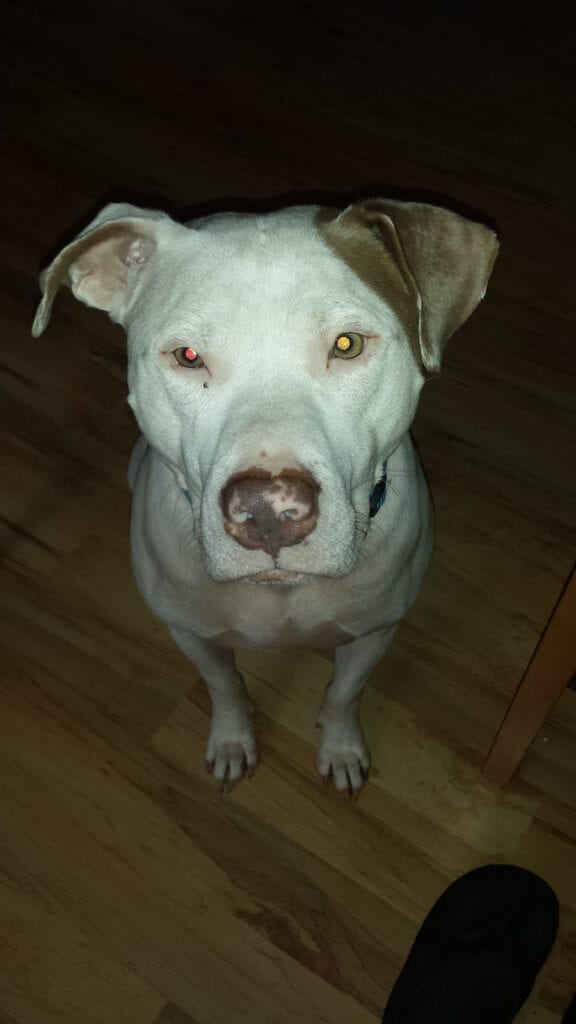We run a dog rescue and spend a lot of time with dogs in our laps or roughhousing on the floor with them. It’s not unusual behavior for one of them to end up standing on my chest. As a dog owner and dog lover, it’s important for me (and you too, I hope!) to understand these odd behaviors to discover what’s happening in those canine noggins. As I’m pinned to the floor by a ninety-pound dog, I can’t help but wonder, “Why does my dog stand on me?”.
Is it dominance? Is he exerting himself as the alpha dog?
Is it affection?
Anxiety?
Ultimately, it comes down to communication. As I learn to translate dog behavior, I am continually impressed with their ingenious methods of responding to us humans. I mean, they can’t just tell us things, so their behaviors are key to understanding their needs.
Is standing on me a dominant behavior from an alpha dog?
There is a lot written about dogs in our homes wanting to be alpha dogs. There is an equal amount written that disputes that.
The pro-alpha dog folks tend to think that dogs are hard-wired from their pre-domesticated days to be pack animals, which means there must be a leader of that pack.
The other side of the coin is those that believe domesticated dogs have had the pack animal inclination bred out through the years, and this does not actually govern their motives. The theory is that dogs look to us for love and protection, not to dominate us.
I’m on the fence, actually. Hate to “not” take a stand, but I’ve seen too much of both.
I have dogs that absolutely feel they are a pack leader, and I have dogs that couldn’t care less.
Rusty, the Pit Bull
Rusty, our pack’s current leader, is a super friendly Pit Bull, but in all things, he is the dominant dog and leads our pack.

He eats first, he sleeps where he wants, he takes the best toys, he snuggles in the best spots, and any new puppy must stand the Rusty test. The Rusty test is always tense (we can discuss that later) but always ends well with Rusty in charge.
The other dogs always “bend the knee,” so to speak. Whether lying on the couch or standing in the kitchen, Rusty will affectionately stand up to us, but not aggressively.
Cody, the Rottweiler, loves to stand on us.
Before Rusty came along, we still had a sizeable pack, and one of those dogs was a Rottweiler. Rotties, you would think, would be natural pack leaders. Let me tell ya, Cody didn’t have the slightest desire to lead anything. He just wanted to romp and play and run and be silly. He could have been the pack leader, but he had no desire to be.
He was our first and only Rottie, but talking to other Rottie owners, it seems this is fairly typical for Rottweilers. And bear in mind, these were Roman legion dogs. What could possibly be more Alpha than a Roman legion dog?
Those are two examples. We’ve seen many more.
So do I believe standing on you is a sign of dominance? I believe it could be, but it doesn’t have to be.
Rusty does this to me, but he knows I’m the real leader and never pushes back on me. So it’s not a challenge nor dominance when he does it. It usually leads to just more play and roughhousing.
Is it dominance if you’re at somebody else’s house with a strange dog, and their dog does it to you? It very well could be. You are in their “lair,” and they are the leader. It very well could be they are standing on you to demonstrate dominance.
Or it could be they want to lick your face.
Baron, the Dachshund – standing on me, you, everything.
Baron gets in our laps, stands on the couch, tries to get in the highest chairs, and whines to be picked up. The common point here is Baron likes to be in high spots. Put him on the floor, and you subject yourself to some serious dog side-eye.

Most smaller dogs tend to want this. It’s often the only way they can make eye contact with you, which is important for dogs. Staring into a dog’s eyes may be taken as a sign of aggression, but often not – usually, it’s just plain love.
He’s also a famous “stand on your chest” pooch.
I feel like Baron uses this since he is so small to appear larger or to try to get the upper hand. He’s a manipulative little guy.
For Baron, I don’t think he’s alpha-dogging anybody; he’s just so dang low to the ground; it’s probably nice for him to get face to face with us, and standing on our chest is a way for him to do that.
When my dog stands on me, is it affection?
I think this is it most of the time. After all, is said and done, our dogs love to cuddle and play, and standing on my chest is a great way to do both.
Dogs look for attention in different ways, and this can be one of them. It’s hard to ignore a pet standing on your chest.
A velcro dog that always sticks to you no matter what may be more guilty of this than others, as this is a great way for them to attach themselves to you.
Is it aggression?
You better hope not. If your dog stands on your chest, his teeth are inches from your face. Not the place for aggressive behavior.
In this case, I recommend no eye contact and gently pushing the dog away while you back away from the dog.
If you truly feel this is an act of outright aggression, you must seek assistance from an experienced and trained behaviorist. Searching for “trained dog behaviorist near me” on Google will give you local options. Dog training is probably in your future.
Standing on you may be a way for your dog to guard you.
If your dog perceives any threat, and if the dog is the type that is protective of you or others, it may be they are putting itself between you and the perceived danger.
I find it interesting that dogs have no concept of life or death, so they have no fear of “ultimate endings” if an encounter goes badly. They’ll protect you to death without hesitation if it’s a protective dog. It’s one of the reasons I love them so much, and I feel I need to protect them from that – I protect them from protecting me.
So if they are standing on you due to something they perceive as a threat, it may be accompanied by growling and barking, and their hair may be standing up. Their tail may be straight up and stiff rather than wagging.
Typical “I’m ready to kick some ass” posture. We’ve all seen our pets do it. The body language is unmistakable.
So be aware of your surroundings. When asking yourself, “Why does my dog stand on me like that, ” look around. Is there something amiss? Or perhaps something your dog thinks is amiss?
How are you feeling today? Perhaps your dog knows…?
Dogs also may hover over us when they detect that we are not feeling well, whether they are picking up on chemical changes or minute physiological ones, such as a change in heart rate, temperature, or blood pressure.
Our dogs routinely lay on us or choose to cuddle a bit more than normal when one of us isn’t feeling great. They know, and they are trying to comfort us.
Could that be it?
What can you do about it?
As with any unwanted dog behavior, redirection is usually a great approach. This may be cute when a puppy or a small dog does it; this behavior can be problematic if that puppy grows into a large dog. Best to nip it in the bud early.
If you sense the situation where it’s about to happen, get yourself or the dog into a position where he can’t do it. Just move. Stand up. Relocate. Get off the floor.
If it’s too late for redirection or avoidance, there’s really not much to do other than to brush them off you. Gently push them, roll them off, etc. Find a way to separate the dog and you – different rooms, behind a gate, etc. This should not be done via a means the dog will necessarily enjoy. If you put the dog outside for a romp, he will learn to associate standing on you with going outside. This isn’t the intended behavior. So choose something like putting them in a room behind a gate, for example, or leave them in the room and go outside.
You get the picture – make the scenario end in a way that doesn’t benefit the dog. A short time-out behind a gate will send a strong message.
No need for reprimand here, as they’ll figure it out. Save the reprimanding for something more serious. And by reprimand, I mean a stern voice. You should never lift your hand to your dog.
If you find this becomes a more persistent behavioral issue, then more aggressive efforts may be needed, but early on, simple distraction and letting them know you don’t care for it should be enough.
Dog Communication 101
Remember that dogs have no concept of guilt, regret, or the ability to worry about their actions. They “do” and face the consequences. Some dogs have less impulse control than others.
The point is that the punishment must match the crime. If it’s a slight offense, the punishment should be slight. But, it’s a key point to catch it early and often. Catch the offense every single time and apply the punishment.
Letting the dog get away with it even once is detrimental to the overall conditioning. You must be consistent.
And keep in mind that redirection is a great method to deal with affronts, as are time-outs. A timeout behind a gate is a great teaching method. It separates the dog, which they don’t like, but it’s not physically harmful. A short timeout session is extremely effective if done consistently.
This is key to understanding dog communication. We tend to mistakenly assign more sophisticated motivations to our dogs than is their due. This is most entertaining when it shows up in comical memes online, but it can cause us to misinterpret the simplicity of how our dogs add one plus one.
If you don’t want that equation to come up with the wrong sum, keep it simple and appeal to the immediacy of reward for dogs. Dogs have zero attachment to guilt, regret, or worry about their actions. However, dogs will remember the human that raises a hand or delivers the blows when there is hardly ever an instance that justifies corporal punishment.
Conclusion: Why does my dog stand on me?
Your dog standing on you does not signal ulterior motives. You do not have to worry about your dog executing his mutinous rebellion over you. If you have had enough of it, it is up to you to remind your dog that he must respect your space.
You cannot deny the social bonds you share with your dog. After all, it proves that your pooch possibly loves you more than you love him. In addition, some dog breeds have a stronger cuddle instinct than others. A “cuddler” may simply be trying to get you to settle down with them.
You will have to assess if this standing on you is for comfort, for playtime, due to anxiety, or the sensation that you need protection. These can be dealt with by redirecting rewards or reconditioning the response.
Other “Why does my dog…” articles:
